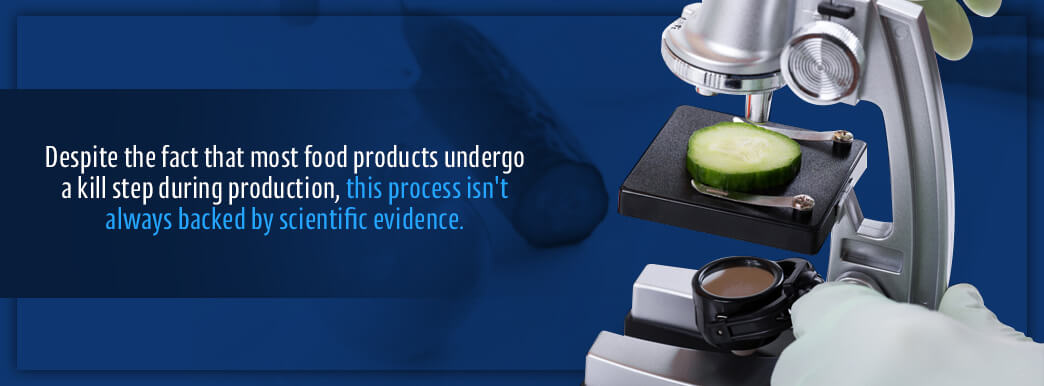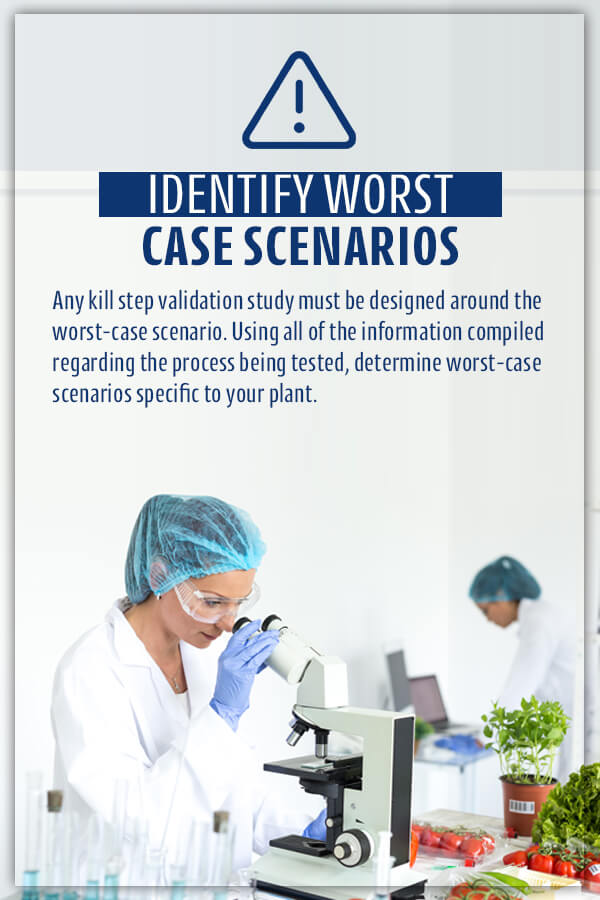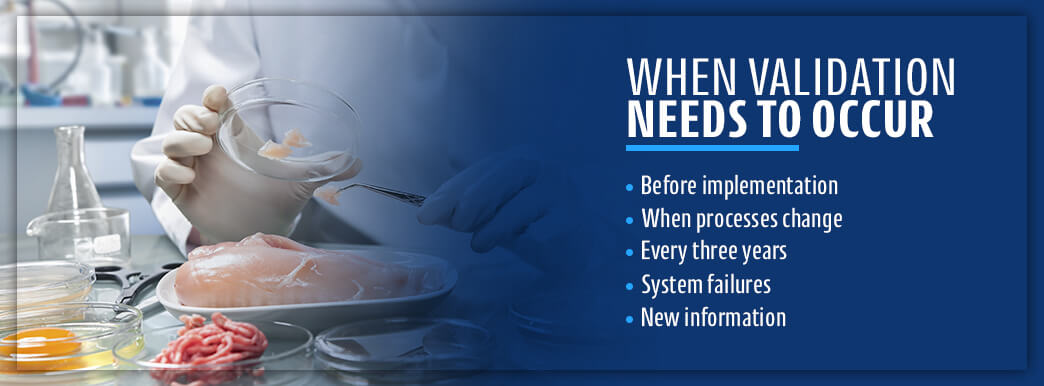
The Importance of Process Validation in the Food Industry
Food safety is a primary concern for the food production industry — new strains of bacteria and viruses can appear at any time, and the food industry must always be ready to combat them for the safety of their consumers.
However, with a wide variety of food types, numerous potential sources of contamination, constantly changing research and a public movement toward less processed foods, food safety procedures can be difficult to develop and assess. It’s particularly difficult to determine how to validate processing procedures.
Validation study is a large part of any food safety program, so it is essential to understand and appropriately implement validation into your organization’s food safety plan.
WHAT IS VALIDATION?
Validation is often confused with verification — while the two steps are both vital food safety components, each describes a different step in the food safety procedure assessment process. While verification confirms that a process functions as intended, validation is the process of collecting information on how to produce food products safely and applying that knowledge to food manufacturing procedures. In other words, validation is the research used to develop a process, while verification is the research used to ensure that the process works.
Validation is a preemptive evaluation based on scientific evidence. Through thorough research, validation studies look into every aspect of the food, from potential hazards to measurement methods to control measures, and assesses how well and how consistently a particular processing procedure or combination of procedures can deliver products that meet food safety specifications.
Of particular interest to the validation process is the kill step — this step in food processing is meant to destroy pathogenic microorganisms in the food. The kill step often involves cooking, frying or extruding the food. Alternatively, the food may be treated with chemical blends, like Log10’s Pre-Liminate probiotic, which prevent, reduce or eliminate pathogen contamination in food without cooking. Kill step validation specifically researches the kill step method and assesses how effectively that method destroys pathogenic microorganisms.
The efficacy of a process in killing pathogenic microorganisms is expressed as logarithmic reduction. Logarithmic or log reduction is the reduction of a pathogen count by an exponential number. For example, if a validation report says that a pathogen count was reduced from 106 to 101, that means that the count went from 1,000,000 cells to 10 cells.
To determine the logarithmic reduction, validation uses a variety of sources for validation proof. Validation proof can include scientific articles, third party experiments, in-plant experiments and mathematical models. This information is then compiled to provide a validation report, which details the exact procedures performed and the logarithmic reduction to expect by following these procedures.
WHY VALIDATION IS IMPORTANT?

Despite the fact that most food products undergo a kill step during production, this process isn’t always backed by scientific evidence. While United States-based manufacturers are overseen by the Food and Drug Administration (FDA), processing plants in other countries can have less comprehensive regulatory oversight, meaning that kill steps may not be researched thoroughly enough. This can result in food being insufficiently cooked to kill all pathogenic microorganisms. When consumed, these undercooked food items can cause an outbreak of foodborne illnesses, posing a threat to public health and costing companies millions in legal fees, recall costs and fines.
One recent example is the outbreak of Listeria monocytogenes due to improperly processed frozen vegetables. In 2018, over 100 countries were affected by a recall of infected frozen vegetables from a Hungarian plant. Forty-seven people across five European nations were affected by Listeriosis caused by the bacteria, which typically involves symptoms including fever, muscle aches and gastrointestinal distress — nine people ended up dying from the infection or related complications. Blanching is the typical kill step used for frozen vegetables, but European suppliers show more reluctance to blanch frozen vegetables to the degree that American consumers and food production companies desire. In the subsequent months, the owners of the plant spent over $35 million on the recall and related costs.
What Happens During the Validation Process
FSMA requires that food processing facilities validate all preventive control in their food safety plan. The three primary requirements for the validation process are to validate preventive control, provide scientific evidence supporting the validation and keep any pertinent documents or records for FDA inspection. These three requirements can be extrapolated into a complete validation process, described in detail below:
1. Assemble a Team
The validation process requires that validation be performed or supervised by a preventive control qualified individual (PCQI), but proper validation requires an effective team. It’s important to have trained professionals take part in the validation process, including qualified microbiologists or food safety experts. A statistician is also essential to the team for their ability to compile and process collected data. Additionally, include relevant personnel who are knowledgable about product formulation, the manufacturing process and other aspects of food processing and safety in the facility. These individuals can provide valuable insight into how processes can be used or altered for maximum efficacy.
2. Set the Scope
When creating a validation plan, list all the equipment, utensils, cleaning regimes and production processes that need to be validated and justify why they need to be involved in the testing. It is particularly important to focus on equipment that is high-risk, such as equipment that is hard to clean or handles large amounts of food with allergenic proteins. Additionally, the validation plan should list all of the pathogens and allergens of concern for your plant — your validation and verification plans should cover all pertinent contaminants.
3. Create a Sampling Plan
Clearly define the sampling points and locations for each item on the validation list. Again, it is ideal to choose high-risk areas — this can include sites where food can get trapped, possible sources of cross-contact or contamination and potentially problematic areas in the cleaning routine. This sampling plan can help determine possible sources of contamination, which can help create a worst-case scenario. This same list will also be used during verification.
4. Establish Acceptance Criteria
For both validation and verification, it is essential to determine what levels of pathogen or allergen are acceptable before undergoing research and testing. Some allergenic foods and pathogens may cause adverse reactions at very low levels, so it is important to determine parameters for every allergen and pathogen being examined. All parameters must be reasonable, measurable and verifiable.
5. Identify Worst-Case Scenarios

Any kill step validation study must be designed around the worst-case scenario. Using all of the information compiled regarding the process being tested, determine worst-case scenarios specific to your plant. This can include sub-optimal temperatures, exposure times, batch loads, concentrations and other factors. Also, consider all the potential areas of contamination.
6. Determine Methods
Once your team has discussed and planned all of the above items, they can determine the rest of the validation methods. This process may involve determining which analytical methods and tests should be used to identify specific pathogens or allergens. These methods are often used during the verification process, as well.
7. Select Surrogates
When working on the validation process, every pertinent pathogen must be analyzed. In some cases, an in-plant study may be necessary to gather accurate data — in these cases, an approved surrogate bacterium must be used. These surrogates have characteristics that are similar to the pathogen being studied, with equal or greater resistance and a scientifically-backed correlation between the two. The microbiologist on your team can help identify the most appropriate surrogates for each pathogen being studied in this way. It’s important to note that even surrogates must be handled carefully during in-plant validation — these organisms can negatively affect sanitation or regulatory requirements and may contaminate the environment if improperly handled.
8. Validate
As soon as methods are set for validation and verification, the validation study begins. Qualified microbiologists or food safety experts, with the help of a statistician, will use their expertise to gather sources, execute experiments and create data models. Validation proof can come from several sources, depending on the scope of the validation — peer-reviewed scientific literature, in-plant studies, third-party experiments and mathematical models can all be used in the validation process.
9. Collect and Analyze Data
When all the testing and research is complete, the team can compile and analyze the data to determine potential areas of improvement. Compare this data to the acceptance criteria determined before the validation study. During this process, your team may find gaps in information or new areas of research that require further validation studies.
10. Prepare a Validation Report
When the validation process is complete, the team must create a validation report so the FDA can look through their findings. This validation report should include:
- An introduction
- Contact information for team members
- Any background information regarding the plant or products being studied
- All parameters studied
- Equipment used
- Methods used
- Microbial strains used
- All results
- A discussion section detailing the significance of the results
These reports must be written with sufficient detail so all aspects of the study are clear and understandable for other food safety experts who may read the report.
11. Verify
Though not strictly a part of the validation process, verification is the next step once validation is complete. At the end of validation, the information gathered from the validation procedure is passed on to the verification team to help establish verification procedures.
When this process is complete, manufacturing companies can use the information gathered to adjust their processes if needed. However, manufacturing process validation is only as good as the team completing the study. For this process to be effective, you need a research team with expertise in the area. Log10 can help.
Maximize Prevention Measures With Log10
With new pathogens constantly appearing, food manufacturing research and development pertaining to health and safety is essential. It’s particularly important to work with a quality research facility staffed with experts in the field. If you’re looking for a reliable pathogen research facility for your validation processes, look no further than Log10.
Log10 provides top-of-the-line pathogen research services for farms, agricultural plants, food processing companies and food storage and distribution centers both nationally and internationally. Our experienced teams are continually looking for new research and methods to provide the best results for our clients, ensuring that your validation process is as thorough as possible. Our services don’t stop at validation, however — we also provide shelf-life studies and probiotic evaluation, production and formulation services to help you find the best solutions for your food products.
Our facilities include biological level 2 pathogen laboratories operating under the most stringent industry standards. Each lab staffs passionate food safety specialists and scientists with extensive experience in isolating, identifying and screening thousands of pathogens. In terms of expertise and reliability, Log10 is a research company you can trust. Learn more about the pathogen research services we offer.
Our experts can give you information on the validation process and how we can help you maximize prevention measures in your
food processing, storage, and distribution companies.
speak to a validation expert today


